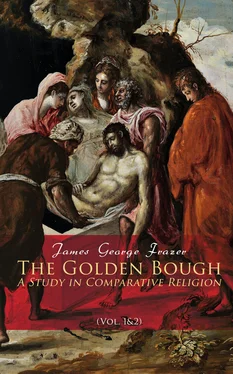No wonder therefore that the savage should rank these human divinities amongst what he regards as the dangerous classes, and should impose exactly the same restraints upon the one as upon the other. For instance, those who have defiled themselves by touching a dead body are regarded by the Maoris as in a very dangerous state, and are sedulously shunned and isolated. But the taboos observed by and towards these defiled persons (e.g. they may not touch food with their hands, and the vessels used by them may not be used by other people) are identical with those observed by and towards sacred chiefs.566 And, in general, the prohibition to use the dress, vessels, etc., of certain persons and the effects supposed to follow an infraction of the rule are exactly the same whether the persons to whom the things belong are sacred or what we might call unclean and polluted. As the garments which have been touched by a sacred chief kill those who handle them, so do the things which have been touched by a menstruous woman. An Australian blackfellow, who discovered that his wife had lain on his blanket at her menstrual period, killed her and died of terror himself within a fortnight.567 Hence Australian women at these times are forbidden under pain of death to touch anything that men use. They are also secluded at child-birth, and all vessels used by them during their seclusion are burned.568 Amongst some of the Indians of North America also women at menstruation are forbidden to touch men's utensils, which would be so defiled by their touch that their subsequent use would be attended by certain mischief or misfortune.569 Amongst the Eskimo of Alaska no one will willingly drink out of the same cup or eat out of the same dish that has been used by a woman at her confinement until it has been purified by certain incantations.570 Amongst some of the Tinneh Indians of North America the dishes out of which girls eat during their seclusion at puberty “are used by no other person, and wholly devoted to their own use.”571 Again amongst some Indian tribes of North America men who have slain enemies are considered to be in a state of uncleanness, and will not eat or drink out of any dish or smoke out of any pipe but their own for a considerable time after the slaughter, and no one will willingly use their dishes or pipes. They live in a kind of seclusion during this time, at the end of which all the dishes and pipes used by them during their seclusion are burned.572 Amongst the Kafirs, boys at circumcision live secluded in a special hut, and when they are healed all the vessels which they had used during their seclusion and the boyish mantles which they had hitherto worn are burned together with the hut.573 When a young Indian brave is out on the war-path for the first time the vessels he eats and drinks out of must be touched by no one else.574
Thus the rules of ceremonial purity observed by divine kings, chiefs, and priests, by homicides, women at child-birth, and so on, are in some respects alike. To us these different classes of persons appear to differ totally in character and condition; some of them we should call holy, others we might pronounce unclean and polluted. But the savage makes no such moral distinction between them; the conceptions of holiness and pollution are not yet differentiated in his mind. To him the common feature of all these persons is that they are dangerous and in danger, and the danger in which they stand and to which they expose others is what we should call spiritual or supernatural, that is, imaginary. The danger, however, is not less real because it is imaginary; imagination acts upon man as really as does gravitation, and may kill him as certainly as a dose of prussic acid. To seclude these persons from the rest of the world so that the dreaded spiritual danger shall neither reach them, nor spread from them, is the object of the taboos which they have to observe. These taboos act, so to say, as electrical insulators to preserve the spiritual force with which these persons are charged from suffering or inflicting harm by contact with the outer world.575
No one was allowed to touch the body of the King or Queen of Tahiti;576 and no one may touch the King of Cambodia, for any purpose whatever, without his express command. In July 1874 the king was thrown from his carriage and lay insensible on the ground, but not one of his suite dared to touch him; a European coming to the spot carried the injured monarch to his palace.577 No one may touch the King of Corea; and if he deigns to touch a subject, the spot touched becomes sacred, and the person thus honoured must wear a visible mark (generally a cord of red silk) for the rest of his life. Above all, no iron may touch the king's body. In 1800 King Tieng-tsong-tai-oang died of a tumour in the back, no one dreaming of employing the lancet, which would probably have saved his life. It is said that one king suffered terribly from an abscess in the lip, till his physician called in a jester, whose antics made the king laugh heartily, and so the abscess burst.578 Roman and Sabine priests might not be shaved with iron but only with bronze razors or shears;579 and whenever an iron graving-tool was brought into the sacred grove of the Arval Brothers at Rome for the purpose of cutting an inscription in stone, an expiatory sacrifice of a lamb and a pig was offered, which was repeated when the graving-tool was removed from the grove.580 In Crete sacrifices were offered to Menedemus without the use of iron, because, it was said, Menedemus had been killed by an iron weapon in the Trojan war.581 The Archon of Plataeae might not touch iron; but once a year, at the annual commemoration of the men who fell at the battle of Plataeae, he was allowed to carry a sword wherewith to sacrifice a bull.582 To this day a Hottentot priest never uses an iron knife, but always a sharp splint of quartz in sacrificing an animal or circumcising a lad.583 Amongst the Moquis of Arizona stone knives, hatchets, etc., have passed out of common use, but are retained in religious ceremonies.584 Negroes of the Gold Coast remove all iron or steel from their person when they consult their fetish.585 The men who made the need-fire in Scotland had to divest themselves of all metal.586 In making the clavie (a kind of Yule-tide fire-wheel) at Burghead, no hammer may be used; the hammering must be done with a stone.587 Amongst the Jews no iron tool was used in building the temple at Jerusalem or in making an altar.588 The old wooden bridge (Pons Sublicius) at Rome, which was considered sacred, was made and had to be kept in repair without the use of iron or bronze.589 It was expressly provided by law that the temple of Jupiter Liber at Furfo might be repaired with iron tools.590 The council chamber at Cyzicus was constructed of wood without any iron nails, the beams being so arranged that they could be taken out and replaced.591 The late Raja Vijyanagram, a member of the Viceroy's Council, and described as one of the most enlightened and estimable of Hindu princes, would not allow iron to be used in the construction of buildings within his territory, believing that its use would inevitably be followed by small-pox and other epidemics.592
This superstitious objection to iron perhaps dates from that early time in the history of society when iron was still a novelty, and as such was viewed by many with suspicion and dislike. For everything new is apt to excite the awe and dread of the savage. “It is a curious superstition,” says a recent pioneer in Borneo, “this of the Dusuns, to attribute anything—whether good or bad, lucky or unlucky—that happens to them to something novel which has arrived in their country. For instance, my living in Kindram has caused the intensely hot weather we have experienced of late.”593 The first introduction of iron ploughshares into Poland having been followed by a succession of bad harvests, the farmers attributed the badness of the crops to the iron ploughshares, and discarded them for the old wooden ones.594 The general dislike of innovation, which always makes itself strongly felt in the sphere of religion, is sufficient by itself to account for the superstitious aversion to iron entertained by kings and priests and attributed by them to the gods; possibly this aversion may have been intensified in places by some such accidental cause as the series of bad seasons which cast discredit on iron ploughshares in Poland. But the disfavour in which iron is held by the gods and their ministers has another side. The very fact that iron is deemed obnoxious to spirits furnishes men with a weapon which may be turned against the spirits when occasion serves. As their dislike of iron is supposed to be so great that they will not approach persons and things protected by the obnoxious metal, iron may obviously be employed as a charm for banning ghosts and other dangerous spirits. And it often is so used. Thus when Scotch fishermen were at sea, and one of them happened to take the name of God in vain, the first man who heard him called out “Cauld airn,” at which every man of the crew grasped the nearest bit of iron and held it between his hands for a while.595 In Morocco iron is considered a great protection against demons; hence it is usual to place a knife or dagger under a sick man's pillow.596 In India “the mourner who performs the ceremony of putting fire into the dead person's mouth carries with him a piece of iron: it may be a key or a knife, or a simple piece of iron, and during the whole time of his separation (for he is unclean for a certain time, and no one will either touch him or eat or drink with him, neither can he change his clothes597) he carries the piece of iron about with him to keep off the evil spirit. In Calcutta the Bengali clerks in the Government Offices used to wear a small key on one of their fingers when they had been chief mourners.”598 In the north-east of Scotland immediately after a death had taken place, a piece of iron, such as a nail or a knitting-wire, used to be stuck into all the meal, butter, cheese, flesh, and whisky in the house, “to prevent death from entering them.” The neglect of this precaution is said to have been closely followed by the corruption of the food and drink; the whisky has been known to become as white as milk.599 When iron is used as a protective charm after a death, as in these Hindu and Scotch customs, the spirit against which it is directed is the ghost of the deceased.600
Читать дальше












